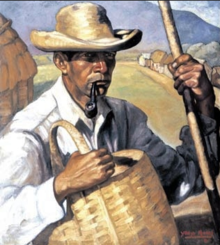
Dominican art comprises all the visual arts and plastic arts made in Dominican Republic. Since ancient times, various groups have inhabited the island of Ayíti/Quisqueya (the indigenous names of the island), or Hispaniola (what the Spanish named the island); the history of its art is generally compartmentalized in the same three periods throughout Dominican history: pre-Hispanic or aboriginal Amerindian (500 BC to 1500 AD), Hispanic or colonial (1502 to 1821 AD), and the national or Dominican period (1844 to present day).[citation needed]
Archeological evidence for human populations on the island go back to around 6,000 years ago, when Archaic Age foragers arrived from South America to the Caribbean island.[1] Going back to the origins of autochthonous art, corresponding to the stage known as prehistoric, primitive or pre-Hispanic, we find several ethnic groups that made up the aboriginal culture: Tainos, Igneris, Ciboneyes, Kalinago and Guanahatabeyes.[2] Of all of them, Taino art was the majority and most widespread throughout the insular territory, leaving behind an abundance of pottery and ceramic structures.
The Taino era of the island came to end after Spanish invasion and colonization, which commenced when Christopher Columbus arrived on the coasts of the island in 1492, leading to their decimation from enslavement, genocide, and foreign diseases. The newly "discovered" island was given the name "La Española" (Hispaniola) and became the first permanent European colony established in the Americas, Santo Domingo, in 1498. In this early period, most artworks were produced in Spain for shipment to Santo Domingo. Much of this early art no longer survive, considering many owners emigrated with their art, countless storms destroyed towns and their works, and Francis Drake's sacking of Santo Domingo in 1586 led to the disappearance of a lot of early colonial art.[3]

The painting movement in Dominican society is young, considering it begins to sow its first fruits in the initial days of the Independence of 1844. Since then, it has manifested in diverse forms and styles produced by the blend of Taino, European, and West African elements found in the culture. The most prominent styles throughout the country's history have been Romanticism, Costumbrismo, Impressionism, Neoclassicism, Naturalism, Expressionism, Surrealism, and Abstract art to name a few. Some the most well known Dominican artists are Jaime Colson, Yoryi Morel, Dario Suro, Celeste Woss y Gil, and Guillo Perez.[citation needed]
- ^ Gershon, Livia. "What Ancient DNA Reveals About the First People to Populate the Caribbean". Smithsonian Magazine. Retrieved 2021-03-06.
- ^ Danilo de los Santos. Memoria de la Pintura Dominicana. (Colección Centenario Grupo León Jimenes) 8v: il. Grupo León Jimenes. Santo Domingo, 2003. pg 76
- ^ Baez, Jennifer. "Hispaniola's early colonial art, an introduction". smarthistory.org. Archived from the original on 2020-10-15. Retrieved 2021-03-06.
© MMXXIII Rich X Search. We shall prevail. All rights reserved. Rich X Search
